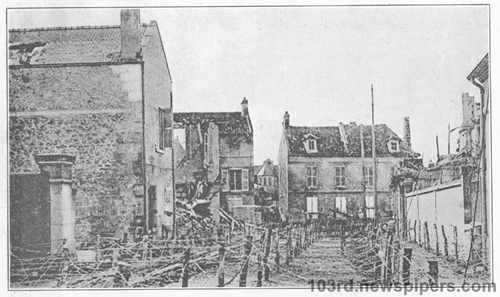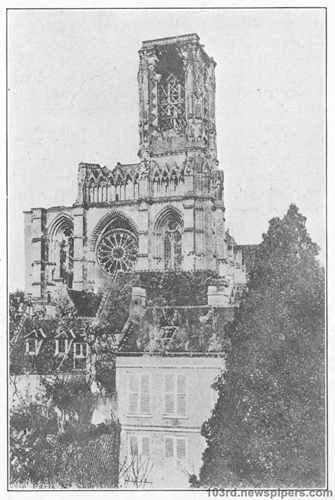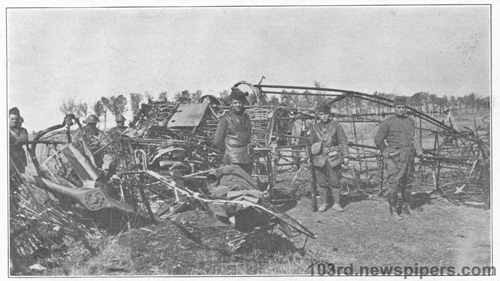
of the 26th Division of the U.S. Army
during World War I
 | The History of the 103rd Regiment of the 26th Division of the U.S. Army during World War I |
| Table of Contents | ||
|
CHAPTER IV SOISSONS-—THE CHEMIN DES DAMES FRONT  O N February 2 an advance party from the lst Battalion in charge of Lieutenant
Halberslebeu left Iriffcl, On February 5 the lst Battalion entrained at Liffol
for Soisscns leaving at 18.50 o’elock. The 2nd Battalion followed at noon of the
sixth, and the 3rd Battalion, that night. Wagon trains accompanied the battal-
ions. ’1`he trains were the standard French troop-1 rains made up of Hat cars and
box ears. The 1st Battalion arrived at Soissons shortly after noon on the sixth,
where it immediately detrained and marched to St. Blaise Quarry; the 2nd Bat-
talion marched to Crouy; and the 3rd, on its arrival on the night of the seventh,
went into barracks at Soissons. `
Before taking up further the movement of the troops a few words about Soissons
may not be out of place. This city had been the storm center of severe actions
since the very beginning of the war. Its position was a strategic one as a distribut-
ing point and railroad center. It had been taken and held by the enemy in 1914,
but only for a short time. In October, 1917, it was the center from which c0un‘ter
operations by the French had been directed, and was still in February, 1918,
subject to long-range artillery fire. Its buildings, houses, and streets bore testi-
mony to the severe fighting that had taken place there. Our men saw the wreck-
age of war in reality. Though the cathedral had been partially restored, part of
O N February 2 an advance party from the lst Battalion in charge of Lieutenant
Halberslebeu left Iriffcl, On February 5 the lst Battalion entrained at Liffol
for Soisscns leaving at 18.50 o’elock. The 2nd Battalion followed at noon of the
sixth, and the 3rd Battalion, that night. Wagon trains accompanied the battal-
ions. ’1`he trains were the standard French troop-1 rains made up of Hat cars and
box ears. The 1st Battalion arrived at Soissons shortly after noon on the sixth,
where it immediately detrained and marched to St. Blaise Quarry; the 2nd Bat-
talion marched to Crouy; and the 3rd, on its arrival on the night of the seventh,
went into barracks at Soissons. `
Before taking up further the movement of the troops a few words about Soissons
may not be out of place. This city had been the storm center of severe actions
since the very beginning of the war. Its position was a strategic one as a distribut-
ing point and railroad center. It had been taken and held by the enemy in 1914,
but only for a short time. In October, 1917, it was the center from which c0un‘ter
operations by the French had been directed, and was still in February, 1918,
subject to long-range artillery fire. Its buildings, houses, and streets bore testi-
mony to the severe fighting that had taken place there. Our men saw the wreck-
age of war in reality. Though the cathedral had been partially restored, part of
 it was still in ruins. A few civilians were in the nity. Before the war it had been
a beautiful city, and still had some fine buildings intact.
Creuy, xx here the 2nd Battalion nmde its first stop, was a small village on the
outskirts of Soissons, principally at mass of ruins. The men were sheltered there
in cellars and dugeuts. St. Blaise Quarry, located near Nanteuil-la-Fosse, was a
tremendous umlergrouml cave capable of accommodating ever a battalion.
Cut out of solid rock, it was an underground village consisting of a system of
large chambers, corridors, and alleys. There were hunks with woven wire or
chicken wire stretched over the frames for the men; a dynamo furnished electric
lights; rats and vermin and bad underground air were the cave’s principal faults;
kitchens were concealed as inueh as possible; the men were fed in the cave, carrying
parties taking the mess te them. This was to eliminate movement as much as
possible and prevent the enemy from discovering how inany troops were quar-
tered there. St. Blaise cave was the station of the support battalion.
Vrcgny, to which the 3rd Battalion moved, was the station of the reserve
battalion, Practically nothing but ruins remained, troops were quartered in
barracks and shelters in lee of the surrounding hills. »
The general system of organization was that for this first tour our troops were
to be brigaded with the French. The 103rd went into line with one battalion in
the front line, one in support, and one in reserve; the front~line battalion had
two companies in line, and two in support. The two line eompaniesfwere in turn
organized in depth with two platoons in front and two in support,
At the time our division and regiment went into the line the Soissons or Chemin
des Dames sector was a quiet one. The French had, however, been active in the
rear, building up their line of resistance, At the very front our front—line com-
panies were alternated with French companies; there, too, in each sector held by
ou1· companies, a detachincnt of French noncoininissioned ofHcers and men was
it was still in ruins. A few civilians were in the nity. Before the war it had been
a beautiful city, and still had some fine buildings intact.
Creuy, xx here the 2nd Battalion nmde its first stop, was a small village on the
outskirts of Soissons, principally at mass of ruins. The men were sheltered there
in cellars and dugeuts. St. Blaise Quarry, located near Nanteuil-la-Fosse, was a
tremendous umlergrouml cave capable of accommodating ever a battalion.
Cut out of solid rock, it was an underground village consisting of a system of
large chambers, corridors, and alleys. There were hunks with woven wire or
chicken wire stretched over the frames for the men; a dynamo furnished electric
lights; rats and vermin and bad underground air were the cave’s principal faults;
kitchens were concealed as inueh as possible; the men were fed in the cave, carrying
parties taking the mess te them. This was to eliminate movement as much as
possible and prevent the enemy from discovering how inany troops were quar-
tered there. St. Blaise cave was the station of the support battalion.
Vrcgny, to which the 3rd Battalion moved, was the station of the reserve
battalion, Practically nothing but ruins remained, troops were quartered in
barracks and shelters in lee of the surrounding hills. »
The general system of organization was that for this first tour our troops were
to be brigaded with the French. The 103rd went into line with one battalion in
the front line, one in support, and one in reserve; the front~line battalion had
two companies in line, and two in support. The two line eompaniesfwere in turn
organized in depth with two platoons in front and two in support,
At the time our division and regiment went into the line the Soissons or Chemin
des Dames sector was a quiet one. The French had, however, been active in the
rear, building up their line of resistance, At the very front our front—line com-
panies were alternated with French companies; there, too, in each sector held by
ou1· companies, a detachincnt of French noncoininissioned ofHcers and men was

|
||
| Original Version of Page |